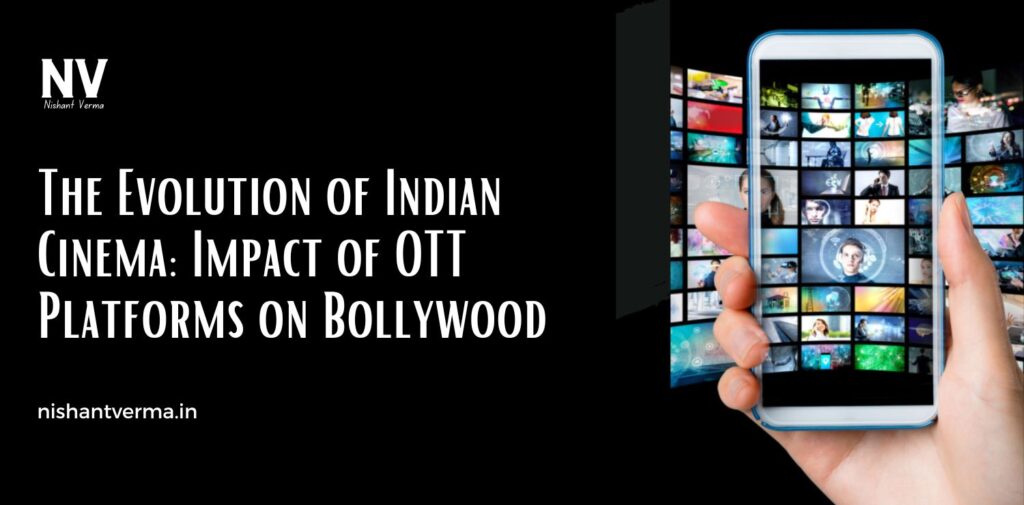Indian cinema, popularly known as Bollywood, has undergone a tremendous transformation over the years. From its humble beginnings in the early 20th century to becoming a global entertainment powerhouse, Bollywood has evolved with changing times and technologies. In recent years, the advent of Over-the-Top (OTT) platforms has added a new dimension to the industry, significantly impacting how films are made, distributed, and consumed.
In this article, we will explore how Indian cinema has evolved, the rise of OTT platforms, and the profound impact they have had on Bollywood.
The Rise of Indian Cinema
Indian cinema began its journey in the early 1900s, with Dadasaheb Phalke’s Raja Harishchandra (1913) being the first full-length feature film. Over the decades, Bollywood blossomed into an influential cultural force. The 1950s to the 1970s are considered the golden era of Bollywood, with filmmakers like Raj Kapoor, Guru Dutt, and Bimal Roy producing timeless classics that explored themes of love, sacrifice, and social issues.
The 1980s and 1990s saw Bollywood embrace a more commercial approach, with larger-than-life films, action heroes, and musical extravaganzas. Actors like Amitabh Bachchan, Shah Rukh Khan, and Salman Khan became household names, and Bollywood’s influence spread beyond India, especially to countries with large Indian diaspora communities.
By the turn of the 21st century, Bollywood had firmly established itself as one of the largest film industries in the world. However, despite its growth, it largely adhered to traditional distribution methods, such as cinema halls, television, and DVDs. This all began to change with the arrival of OTT platforms.

The Rise of OTT Platforms
OTT platforms, such as Netflix, Amazon Prime Video, Disney+ Hotstar, and others, started making their presence felt in India around the mid-2010s. These platforms provide streaming services directly over the internet, bypassing traditional cable and satellite television, and offer a vast library of movies, TV shows, and web series. With the increasing availability of high-speed internet and affordable smartphones, OTT platforms quickly became popular, especially among younger audiences who sought on-demand content.
In India, OTT platforms revolutionized the entertainment industry by offering content in multiple languages, catering to regional tastes, and providing a diverse range of genres and formats. Unlike traditional movie releases, OTT platforms allow viewers to watch films and shows at their convenience, with no time or location restrictions. This accessibility, combined with the growing internet penetration, led to a surge in the number of users, and many Bollywood filmmakers began to take notice of the potential these platforms held.
Changing Content Consumption Patterns
One of the biggest impacts of OTT platforms on Bollywood has been the shift in content consumption patterns. Traditionally, Bollywood movies were made with a one-size-fits-all approach, targeting a broad audience with commercial elements like romance, action, drama, and music. Theatres were the primary mode of watching films, and once a movie left the big screen, it would be available for home viewing on television, months later.
However, with the rise of OTT, the audience now has access to a vast array of content from both Bollywood and international film industries. People can watch movies in different languages, explore niche genres, and binge-watch entire seasons of web series. This change in consumption has led to an increased demand for content that is more diverse, innovative, and experimental. As a result, Bollywood filmmakers have begun to create movies and web shows that are more tailored to specific audiences and focus on unique, often unconventional storylines.
OTT platforms have also given rise to the concept of direct-to-digital releases. This means that several films are now being released directly on streaming platforms, bypassing traditional theatrical releases. The pandemic, in particular, accelerated this shift, as movie theatres were closed, and OTT platforms became the go-to option for film releases. Films like Ludo, Gulabo Sitabo, and Chhalaang premiered on OTT platforms, opening new doors for filmmakers to reach their audiences without relying on theatres.

Impact on Bollywood Filmmaking
OTT platforms have not only changed how audiences consume content but also how films are made in Bollywood. The nature of storytelling, production values, and even the length of films have evolved due to the demands of digital platforms.
a. Diversification of Genres
With OTT platforms offering a vast range of content, Bollywood has embraced a wider variety of genres. While commercial films dominated theatres in the past, the OTT platforms have allowed for the creation of films and shows that explore new themes and unconventional narratives. Genres such as crime thrillers, psychological dramas, political thrillers, and slice-of-life stories are now more prevalent. Stories that may have once been considered too niche for a mainstream Bollywood film are now being embraced and appreciated by digital audiences.
b. Experimentation and Risk-Taking
One of the most exciting changes brought about by OTT platforms is the increased willingness to experiment with unconventional and bold content. Bollywood filmmakers are now more willing to explore taboo subjects, socially relevant issues, and experimental narratives. Films and web series on OTT platforms have tackled topics like LGBTQ+ rights, mental health, and gender equality, which were rarely addressed in mainstream Bollywood cinema before.
Additionally, OTT platforms have allowed filmmakers to take creative risks without the pressure of catering to a mass audience. This has led to the production of films and shows that may not have found a place in traditional cinemas but have been highly successful and critically acclaimed on OTT platforms. Shows like Sacred Games and Mirzapur are examples of how the digital platform has allowed for deeper, more complex storytelling.
c. International Collaborations and Global Reach
OTT platforms have also opened up new opportunities for Bollywood filmmakers to collaborate with international talents and reach global audiences. By distributing content on a global scale, Bollywood films and shows now have a wider reach than ever before. This international exposure has led to cross-cultural collaborations, where Indian filmmakers work with global actors, directors, and producers, further enhancing the global appeal of Indian cinema.
Films like Lal Kaptaan and The White Tiger, which were made with international collaborations and released on Netflix, highlight how Bollywood content is being embraced worldwide. This global reach has given Indian filmmakers an opportunity to expand their audience base beyond the borders of India, making Bollywood a more inclusive and internationally recognized industry.
Changing Stars and New Talent
The rise of OTT platforms has also led to a shift in the way stars are made in Bollywood. While big-budget films traditionally relied on established stars to draw audiences, OTT platforms have allowed fresh, new talent to shine. Actors and filmmakers who were previously not part of mainstream Bollywood have now found a platform to showcase their skills.
Web series like Sacred Games, Made in Heaven, and The Family Man introduced audiences to new faces and talents who have since become popular stars in their own right. The platform has thus democratized the entertainment industry, allowing more room for diversity in both the talent pool and the stories being told.

The Future of Bollywood and OTT
The rise of OTT platforms has undoubtedly changed Bollywood forever. As the digital revolution continues to grow, Bollywood’s reliance on OTT platforms is expected to increase. The future of Indian cinema will likely see more hybrid releases, with films being launched in theatres and on digital platforms simultaneously.
With increasing investments in digital content, more collaborations between Indian and international filmmakers, and a growing demand for innovative stories, the possibilities for Bollywood are endless. As audiences continue to evolve, so too will the way they engage with films, pushing Bollywood to experiment and embrace new forms of storytelling and production.
Conclusion
The consequence of OTT platforms on Bollywood has been transformative. From changing how films are made and consumed to creating new opportunities for talent and experimentation, OTT platforms have reshaped the very fabric of Indian cinema. Bollywood has adapted to these changes by embracing diversity, taking creative risks, and expanding its reach to a global audience.
As the digital era continues to grow, it will be exciting to see how Bollywood evolves further and what new trends emerge. The future of Indian cinema lies in its ability to adapt, innovate, and continue delivering stories that resonate with audiences around the world.




